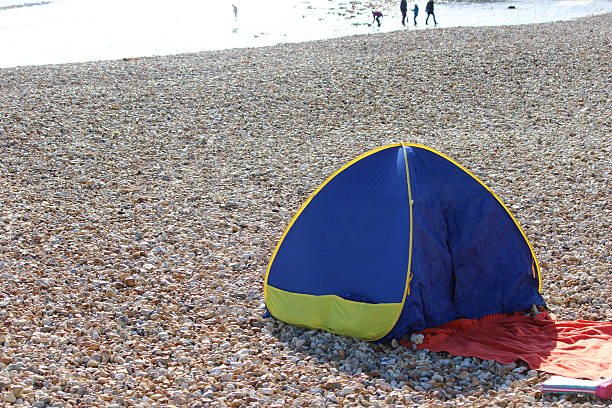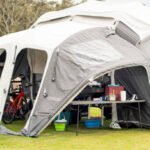Camping is one of the most enjoyable outdoor activities. Being out in nature, breathing fresh air, and sleeping under the stars is an amazing experience. However, your camping adventures rely heavily on having the right gear, especially a quality tent. Pop-up tents are one of the most popular options for campers because they are so quick and easy to set up. In this guide, we’ll explore everything you need to know about pop-up tents to help you pick the perfect model for your next camping trip.
What is a Pop Up Tent?
A pop-up tent is a type of instant or automatic tent. It gets its name from the way it “pops up” into place within seconds after you take it out of its carrying bag.
Pop-up tents use a spring-loaded pole system. The poles are pre-attached to the tent fabric and folded up neatly when packed. Once unpacked, the poles spring into their fully extended position, pulling the tent fabric taut. Most pop-up tents then only require you to secure the corners to stand up. It’s a revolutionary design compared to traditional tents where you have to manually thread poles through sleeves and stake down the corners.
The ease and speed of the pitch are the biggest appeal of pop-up tents. Even first-time campers can have one of these tents fully pitched within just 1-2 minutes. They are incredibly hassle-free and ideal for groups and families where time and simplicity are priorities.
Benefits of Pop-Up Tents
There are many great reasons to choose a pop-up tent for your next camping trip:
- Quick and easy setup – As already mentioned, the effortless pitch of pop-up tents is their biggest draw. Simply take it out of the bag and let it pop up by itself in seconds.
- Compact and portable – Pop-up tents fold down into a neatly packed size since the poles are pre-attached. They take up less space in your car and are easier to transport to your campsite.
- Weather resistant – Pop-up tents are made of durable, water-resistant fabrics. Many are coated with polyurethane or have taped seams to keep rain and moisture out.
- UV protection – Tent fabrics have UV-blocking treatments to provide sun protection from harmful rays.
- Lots of sizes – Pop-up tents come in a range of sizes from 1-person models up to 10+ person family-sized tents. You’ll have plenty of options to suit your needs.
- Affordable prices – Due to their simple construction, pop-up tents are very competitively priced compared to more complex pole tents. Even large models won’t break the bank.
- Ideal for festivals and events – The fast pitch makes pop-ups perfect for crowded events where space is limited. They provide a quick shelter solution.
What to Look for When Buying a Pop-Up Tent
Keep these key factors in mind when shopping for the best pop-up tent:
Size
Consider how many people need to sleep inside. Pop-up tents commonly fit 2, 4, 6, 8, or more sleepers. Check the dimensions to ensure there is adequate space. Taller people will appreciate extra interior headroom as well.
Season Rating
3-season tents are suitable for spring, summer, and fall camping. For winter camping or snowy conditions, look for a 4-season tent rated to withstand high winds, heavy rain, and snow loads.

Fabric Denier
The denier rating indicates the thickness and durability of the tent fabric. Higher denier fabrics last longer and are more puncture-resistant. Look for at least 150D to 180D fabric on top-quality pop-up tents.
Waterproofing
Make sure the pop-up tent has waterproof fabrics and seam sealing to prevent leaks in wet weather. Taped or welded seams add further protection. The rain fly should provide full coverage.
Ventilation
Proper ventilation prevents condensation build up inside the tent. Look for mesh panels, roof vents, and door screens to allow airflow.
Ease of Packing
Since pop-up tents fold into a disc shape, consider the packed size for easy transport. Wheeled carry cases are another handy feature.
Doors and Windows
Models with multiple doorways and windows allow more access, views, and airflow. Make sure windows have cover flaps or mesh screens.
Flooring
Some pop-up tents come with sewn-in flooring. Others are floorless and require a separate tarp or footprint. Flooring helps keep the interior clean and dry.
Weight
Lighter tents around 5 pounds are better for backpacking, while heavier models 10+ pounds are fine for car camping.

Setting Up a Pop-Up Tent
Pitching a pop-up tent is incredibly simple thanks to the spring-loaded poles:
- Find a level campsite free of rocks, sticks, and other debris. Clear the area if needed.
- Remove the tent from the carry bag and unfold it with the doors facing the desired direction.
- Let go and take a step back as the tent springs open into position. This should only take a few seconds!
- Secure the corners of the tent by staking down the webbing loops or grommets. Use included stakes or strong substitutes.
- Pull the fabric taut for a drum-tight pitch. Check for levelness.
- Close all zippered doors and secure the rain fly if there is one.
- You’re all done! Get your sleeping gear inside and enjoy your home away from home.
With practice, you’ll be a pro at pitching your pop-up tent in just 60 seconds. It’s incredibly fast and frustration-free compared to conventional pole tents.
Pop-Up Tent Care and Maintenance Tips
Follow these tips to get the longest life out of your pop-up tent:
- Let the tent air dry completely before packing away to prevent mildew.
- Use a mild soap and sponge to clean off dirt. Never use harsh detergents.
- Check for damage after trips and apply seam sealant to any new tears or openings.
- Keep tent fabric free of stains by reapplying waterproofing treatments periodically.
- Avoid forcing poles into position; allow them to extend naturally to avoid breakage.
- Check pole segments for signs of cracking and replace individual parts as needed.
- Tighten any loose pole or stake joints as needed.
- Store the tent in a dry place out of direct sunlight when not in use.
- Don’t leave the tent pitched for extended periods as UV exposure can degrade the fabrics.
With proper care and precautions, a quality pop-up tent can realistically last for 5+ years of camping adventures.

Finding the Best Pop-Up Tent for Your Needs
The market has no shortage of pop-up tent models to consider. Here are some top-rated options to consider across different price points and features:
Budget Pop Up Tents Under $100
- Lightspeed Outdoors 2-Person Pop-Up Tent – Compact 2-person tent with 43″ center height. Good for weekends and short trips.
- FiveJoy Instant Pop-Up Tent – This very affordable 4-person tent with large doors and an extended rainfly awning.
- Zomake Pop-Up Tent – Well-ventilated 2-3-person tent with mesh roof vents and side windows.
Mid-Range Pop-Up Tents $100-$200
- Coleman 6-Person Cabin Tent – Spacious interior with room divider and welded floors. Fast 60 second setup.
- Wnnideo Instant Family Tent – Feature-packed 6-person tent with tall center height and large rain fly. Great value.
- Core Instant Cabin Tent – Popular 4-person tent from a trusted brand. Good ventilation and fully taped seams.
High-End Pop-Up Tents $200+
- Kodiak Canvas Flex-Bow Deluxe Tent – This luxurious tent is built to last with hydra-shield canvas fabric. Easy setup with top-quality materials.
- Big Agnes Bunk House 4 Tent – Roomy 4-person tent with two doors and vestibules. Designed to withstand strong winds.
- Nemo Wagontop 6P Tent – Spacious car camping tent with multiple doors, windows, and interior pockets and shelves.
Frequently Asked Questions About Pop-Up Tents
How are pop-up tents so easy to set up?
Pop-up tents use an innovative spring-loaded pole system so that the poles automatically extend into position when you unpack the tent. This self-pitching mechanism allows pop-up tents to be fully set up within 1-2 minutes.
How do you close a pop-up tent?
Start by ensuring all zippered doors are fully closed and secured. Then gently push in the top and sides of the tent to relax the pole tension and allow the tent to fold down nicely into a disc shape for packing. Finally stuff the tent into its carry bag, rolling tightly to remove excess air.
Can you put a pop-up tent back in its bag?
Yes, pop-up tents are designed to be re-packed into their original carry bags. It may take some practice to master the technique. Start by closing doors, relaxing the poles, and flattening the tent before tightly rolling it up from one side. Then gently fit it back in the bag, squeezing air out as you go.
What is the best tent for windy conditions?
Look for a pop-up tent with a low, aerodynamic shape and sturdy dome-style poles that can better withstand high winds. 4-season tents also tend to be more wind resistant. Double-check that the stakes, guy lines, and pole joints are all well-secured too.
How do I clean my pop-up tent?
Use a mild soap and warm water to spot-clean your tent fabric as needed. Gently rub soiled areas and rinse away all soap residue. Allow the tent to fully air dry before packing it up. Harsh chemicals can damage the waterproof coatings.
Should I get a 3 or 4-season tent?
3-season tents are suitable for fair-weather camping during spring, summer, and fall. 4-season tents have stronger frames and fabrics to withstand winter winds, rain, and snow loads. Go with a 4-season model if camping anytime outside the warmer months.
What are tent vestibules used for?
Vestibules are covered outdoor extensions of the tent, usually at doorways. They provide sheltered storage space for gear, shoes, packs, and pets so that the tent’s interior stays clean. Vestibules are also handy for cooking if the main area is crowded.
Can you put a tent back in its bag?
Yes, tents are designed to be re-packed into their carry bags. It does take some technique though. Ensure poles and components are disassembled, then flatten out the tent fabric before tightly rolling it up along the length. Pack the poles separately. Go slow and squeeze out excess air.
My Closing Thoughts
Pop-up tents make camping quicker, easier, and more convenient for on-the-go outdoorsmen. Their innovative spring-loaded poles allow you to pitch a tent in just seconds compared to traditional setup routines. Pop-up tents come in a full range of sizes for any number of sleepers and offer ample protection from the elements when you need a comfortable shelter. Use this guide to select the ideal pop-up tent model for your next adventure. Master the quick setup process and enjoy the perks of fast and frustration-free camping trips for years to come.


